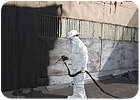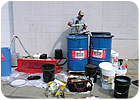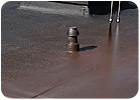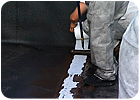Set in an Instant, Devised for the Long Haul
The makers of Instacoat are quick to point out
that their water-based seamless waterproof membrane has some unique
characteristics, and point to product testing and real-world applications as
proof of a promising future.

People in every industry are on the lookout for a better product. They also want a history of solid performance. The problem is it’s impossible to have a revolutionary breakthrough product with a proven track record, but that doesn’t keep innovators from forging ahead where others have failed.
The makers of Instacoat are quick to point out that their water-based seamless waterproof membrane has some unique characteristics, and point to product testing and real-world applications as proof of a promising future. According to the manufacturer, the product, manufactured as Instacoat by Asphalt Materials Inc. and distributed as D-Max by DeWitt Products Co., has an elongation of more than 1,000 percent and a recovery rate of 98 percent. It has self-healing and self-sealing properties. Furthermore, it emits no fumes or volatile organic compounds (VOCs), and it can be applied until the first drop of rain hits the ground.
The manufacturer asserts that while the product is revolutionary, it can be seen as the next step in an evolutionary process. Mike Dewald of Asphalt Materials Inc. says the secret is in the manufacturer’s proprietary rubber formulation, developed after extensive research and development. The result, according to Dewald, is a two-component system made up of a highly modified asphalt emulsion and a chemical reactant. It goes on brown and dries black, fully curing in 24 to 72 hours, depending on thickness, temperature and humidity. In roofing applications, the manufacturer recommends covering the base product with a white acrylic or aluminum top coat.
"Instacoat is a safe and environmentally friendly alternative to conventional hot-applied and solvent membrane systems because it is water-based, non-toxic, emits no VOCs and contains no solvents," Dewald states. The product is available in spray grade, trowel grade and roller brush grade, and it is Miami-Dade County Product Control approved (NOA number 06-1020.04). It also meets the requirements of ICC AC-29 Table 1 for below-grade waterproofing.

Donald McClellan, president of DeWitt Products, notes that the product can be used in lieu of blue tarps as a quick fix for roofs blown off in storms, in remedial roof restoration projects and for coating metal roofs. The bottom line is the performance of the product after it’s cured," he says. "We include UV stabilizers to increase the performance of the product on roofs."
"The spray application is ideal for roofs with numerous penetrations and lots of HVAC equipment," says Jack McClellan, vice president of research and development for DeWitt Products. "Plus, overspray is minimal on a normal day, as these are fairly large particles."
The product should be applied at a 90-degree angle to the deck, with a minimum of one pass in each direction. There are temperature and weather constraints, and product literature notes that it should not be applied in extreme heat or when the temperature is below 40 degrees Fahrenheit. "It cannot be applied during a rainstorm, but if it rains after the product is down, that’s fine," says Dewald.
The low-pressure, high-volume spray pump is designed to be user-friendly and easy to clean. The system is driven by a 5-horsepower Honda engine, and two guns may be used simultaneously. A three-man crew can put down 8,000 to 10,000 square feet a day on average, according to Dewald. Cleanup takes just a few minutes, and the manufacturer suggests running mineral spirits through the pump and warm water through the activator side after each use.
The product is only authorized for use by certified applicators, and Dewald conducts much of the training himself. "The ideal situation is to train them on a job," he says. "We teach all the techniques in the classroom, and then train the applicators on the jobsite."

With some other products, fear of rain can wreak havoc with the schedule, but concerns about inclement weather are minimized with Instacoat, according to Doyle. "You can apply it until the rain hits your shoulder before you have to shut the machine down," he states. "It sets in an instant. That’s why they call it Instacoat."
Garrett Cocker has also been impressed with the performance of Instacoat. His company, Alberton, headquartered in Edmond, Okla., does commercial roofing, waterproofing and general contracting work. "Our spray techs have been involved with it now for a few years," says Cocker. "It’s worked very well and it does exactly what it says it will."
"The self-sealing property is fantastic. It’s elastic and it has self-adhesion, so its ability to seal around existing penetrations is big," continues Cocker. "It can be the perfect way to buy more time for a roof. The bottom line is, if you can extend the life of the roof so the building owner can continue business at a reasonable price, it’s a win-win situation all the way around."

"We get a lot of rain down here," says Allison. "With a roof that’s got a lot of damage, you might have to strip it down, and weather can be a problem. I just tear off what I’m going to spray that day and seal it up day to day, so I keep it waterproof. It bonds to itself, and if it rains unexpectedly, I just stop spraying. Water just can’t harm it. It’s very user friendly, especially in areas with a lot of rain and high humidity."
Another satisfied applicator is Tom LeBoeuf, president of Duracover Rubberized Coatings, Chatham, Ontario. "I was impressed by its consistency, quality, the engineering and technology, as well as the backup from the companies behind the product."
He appreciates the versatility of the product. "It has the capability to adhere to a number of substrates - wood, concrete, brick and most roofing materials," says LeBoeuf. " It can even be applied to green concrete that is not fully cured."
LeBoeuf emphasizes that the condition of the substrate is the key to a successful application. "With proper cleaning and preparation of the right substrate, you get excellent adhesion, excellent performance," he says. "Water in the substrate can pose a problem. We tell our trainers, ‘If it’s too slick, it won’t stick.’ If there is water on the surface, or if there is a lot of oxidation in the metal, it could reduce the adhesion."
LeBoeuf is optimistic about the future of the product. "The product isn’t a cure for all problems, but it is a great solution for many problems," he says.
Will Instacoat/D-Max be the better mousetrap innovators dream of? Time will tell. "New products have to prove themselves," concludes LeBoeuf. "If everyone stuck with the old thinking, we wouldn’t have EPDMs and TPOs. We’re at the new frontier. We’ll have our challenges, but we’ll meet those challenges one roof at a time, one foundation at a time."
For more information about Instacoat, contact Mike Dewald at 800-377-2711. For more information about D-Max, contact DeWitt Products Co. at 800-962-8599 or visit www.dewittproducts.com.

Tim Sheridan of DeWitt Products Co. conducts a product
demonstration of Instacoat/D-Max on various substrates at the company’s Detroit
headquarters.
People in every industry are on the lookout for a better product. They also want a history of solid performance. The problem is it’s impossible to have a revolutionary breakthrough product with a proven track record, but that doesn’t keep innovators from forging ahead where others have failed.
The makers of Instacoat are quick to point out that their water-based seamless waterproof membrane has some unique characteristics, and point to product testing and real-world applications as proof of a promising future. According to the manufacturer, the product, manufactured as Instacoat by Asphalt Materials Inc. and distributed as D-Max by DeWitt Products Co., has an elongation of more than 1,000 percent and a recovery rate of 98 percent. It has self-healing and self-sealing properties. Furthermore, it emits no fumes or volatile organic compounds (VOCs), and it can be applied until the first drop of rain hits the ground.
The manufacturer asserts that while the product is revolutionary, it can be seen as the next step in an evolutionary process. Mike Dewald of Asphalt Materials Inc. says the secret is in the manufacturer’s proprietary rubber formulation, developed after extensive research and development. The result, according to Dewald, is a two-component system made up of a highly modified asphalt emulsion and a chemical reactant. It goes on brown and dries black, fully curing in 24 to 72 hours, depending on thickness, temperature and humidity. In roofing applications, the manufacturer recommends covering the base product with a white acrylic or aluminum top coat.
"Instacoat is a safe and environmentally friendly alternative to conventional hot-applied and solvent membrane systems because it is water-based, non-toxic, emits no VOCs and contains no solvents," Dewald states. The product is available in spray grade, trowel grade and roller brush grade, and it is Miami-Dade County Product Control approved (NOA number 06-1020.04). It also meets the requirements of ICC AC-29 Table 1 for below-grade waterproofing.

Instacoat/D-Max spray grade rubber shield is applied with a
low-pressure, high-volume spray pump driven by a 5-horsepower Honda engine.
Applications
The product is designed for use on vertical or horizontal surfaces in numerous applications, including roofing, waterproofing, corrosion control and secondary containment. It can be applied to most substrates, including BUR, modified bitumen, EPDM, PVC, hypalon, TPO, metal, wood, concrete and plastic. Use directly over coal-tar pitch roofs should be avoided. Substrate preparation is essential, and the deck should be clean, dry, and lightly textured or etched.Donald McClellan, president of DeWitt Products, notes that the product can be used in lieu of blue tarps as a quick fix for roofs blown off in storms, in remedial roof restoration projects and for coating metal roofs. The bottom line is the performance of the product after it’s cured," he says. "We include UV stabilizers to increase the performance of the product on roofs."
"The spray application is ideal for roofs with numerous penetrations and lots of HVAC equipment," says Jack McClellan, vice president of research and development for DeWitt Products. "Plus, overspray is minimal on a normal day, as these are fairly large particles."
The product should be applied at a 90-degree angle to the deck, with a minimum of one pass in each direction. There are temperature and weather constraints, and product literature notes that it should not be applied in extreme heat or when the temperature is below 40 degrees Fahrenheit. "It cannot be applied during a rainstorm, but if it rains after the product is down, that’s fine," says Dewald.
The low-pressure, high-volume spray pump is designed to be user-friendly and easy to clean. The system is driven by a 5-horsepower Honda engine, and two guns may be used simultaneously. A three-man crew can put down 8,000 to 10,000 square feet a day on average, according to Dewald. Cleanup takes just a few minutes, and the manufacturer suggests running mineral spirits through the pump and warm water through the activator side after each use.
The product is only authorized for use by certified applicators, and Dewald conducts much of the training himself. "The ideal situation is to train them on a job," he says. "We teach all the techniques in the classroom, and then train the applicators on the jobsite."

The product sprays brown and cures black, and the
manufacturer recommends covering it with a white top coat after it cures.
Success in the Field
Cecil Doyle, the owner of Commercial Roofing Systems Inc., based in Starks, La., first used Instacoat on the roof of a large warehouse where expansion had created leaks at the seams. Doyle’s company received two more jobs from the same customer as a result of that first application. "This product worked," says Doyle. "It took care of the problem. It sold them, and it sold me."With some other products, fear of rain can wreak havoc with the schedule, but concerns about inclement weather are minimized with Instacoat, according to Doyle. "You can apply it until the rain hits your shoulder before you have to shut the machine down," he states. "It sets in an instant. That’s why they call it Instacoat."
Garrett Cocker has also been impressed with the performance of Instacoat. His company, Alberton, headquartered in Edmond, Okla., does commercial roofing, waterproofing and general contracting work. "Our spray techs have been involved with it now for a few years," says Cocker. "It’s worked very well and it does exactly what it says it will."
"The self-sealing property is fantastic. It’s elastic and it has self-adhesion, so its ability to seal around existing penetrations is big," continues Cocker. "It can be the perfect way to buy more time for a roof. The bottom line is, if you can extend the life of the roof so the building owner can continue business at a reasonable price, it’s a win-win situation all the way around."

Substrate preparation is essential, and the use of roofing
fabric is recommended over existing seams.
Below Grade, Above the Building
Rick Allison is the owner of Envirotech in Muscle Shoals, Ala. The 30-year-old company does 70 percent of its work in roofing and the remaining 30 percent in waterproofing. He first used the product as a secondary containment liner for hydrochloric acid tanks. Since then he has used it in numerous applications, including pond liners and roofing jobs. "We recently reroofed a bank and a school building, two 100-year-old buildings with flat roofs," says Allison. "It can be applied while school is in session or work is going on." The bank had leaky parapet walls, and numerous attempts to stop the leaks had failed. "We put down some roofing fabric and squeegeed the roller-grade material over the fabric, then sprayed over the top of that, with excellent results.""We get a lot of rain down here," says Allison. "With a roof that’s got a lot of damage, you might have to strip it down, and weather can be a problem. I just tear off what I’m going to spray that day and seal it up day to day, so I keep it waterproof. It bonds to itself, and if it rains unexpectedly, I just stop spraying. Water just can’t harm it. It’s very user friendly, especially in areas with a lot of rain and high humidity."
Another satisfied applicator is Tom LeBoeuf, president of Duracover Rubberized Coatings, Chatham, Ontario. "I was impressed by its consistency, quality, the engineering and technology, as well as the backup from the companies behind the product."
He appreciates the versatility of the product. "It has the capability to adhere to a number of substrates - wood, concrete, brick and most roofing materials," says LeBoeuf. " It can even be applied to green concrete that is not fully cured."
LeBoeuf emphasizes that the condition of the substrate is the key to a successful application. "With proper cleaning and preparation of the right substrate, you get excellent adhesion, excellent performance," he says. "Water in the substrate can pose a problem. We tell our trainers, ‘If it’s too slick, it won’t stick.’ If there is water on the surface, or if there is a lot of oxidation in the metal, it could reduce the adhesion."
LeBoeuf is optimistic about the future of the product. "The product isn’t a cure for all problems, but it is a great solution for many problems," he says.
Will Instacoat/D-Max be the better mousetrap innovators dream of? Time will tell. "New products have to prove themselves," concludes LeBoeuf. "If everyone stuck with the old thinking, we wouldn’t have EPDMs and TPOs. We’re at the new frontier. We’ll have our challenges, but we’ll meet those challenges one roof at a time, one foundation at a time."
For more information about Instacoat, contact Mike Dewald at 800-377-2711. For more information about D-Max, contact DeWitt Products Co. at 800-962-8599 or visit www.dewittproducts.com.
Looking for a reprint of this article?
From high-res PDFs to custom plaques, order your copy today!







